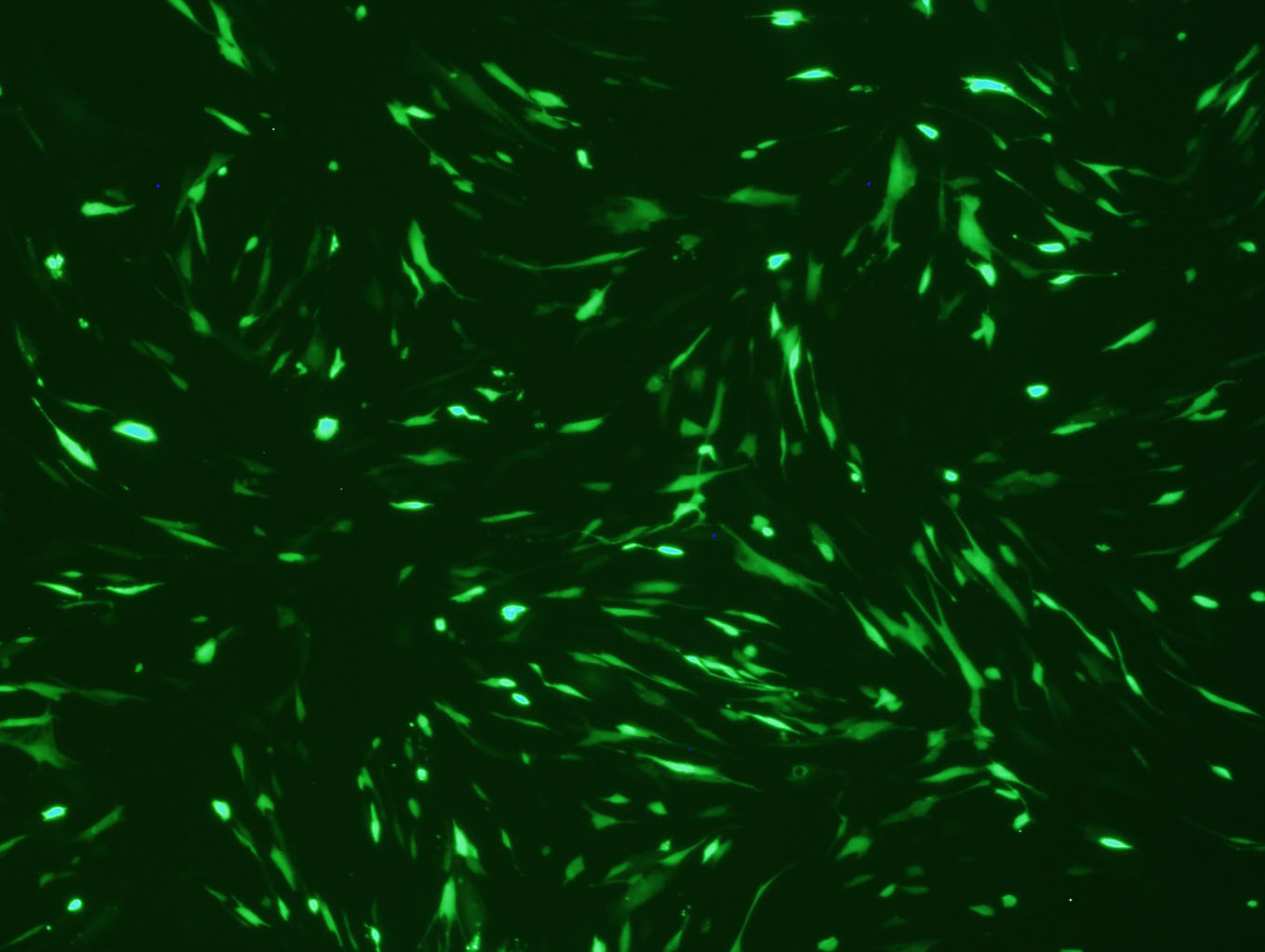Description
Cell to transfect:
Cell Name: Human Dermal Fibroblast (HDF)
Cell Synonyms: HDF, NHDF-AD, NHDF-Neo, NHDF
Fibroblasts are found in all connective tissues, and they synthesize and secrete extracellular matrix proteins under cell culture conditions. Human Dermal Fibroblasts (HDF) are derived from the dermis of normal human neonatal foreskin or adult skin. They are a well established system for in vitro analysis of fibroblast growth, migration and collagen metabolism in wound healing. Fibroblasts grown in a biodegradable mesh have been used as a living dermal replacement.
Applications:
- ECM protein analysis
- Wound healing
- Collagen metabolism
- Cosmetics
- Skin therapy/models
The Transfection Reagent Features:
- Broad spectrum for the transfection of large plasmid, mRNA, siRNA, and/or other type of nucleic acids, which is best for co-transfection of different type and/or size of nucleic acids.
- Specifically optimized to deliver nucleic acids into HDF
- Highest efficiency to ensure experimental success
- Extremely gentle to cells
- 0.5 ml is able to transfect about 1000 wells of 24-well plate
- Deliver single or multiple plasmids
- synthesized from 100% animal origin-free components, making it easy to validate the absence of zoonotic diseases, such as BSE or viruses, in research experiments or cells lines
- Compatible with serum
- Compatible with transfection in any plate formats
- Reproducible: due to highly controlled chemical synthesis of each of the ingredients, the reagent forms uniformly sized complex particles with nucleic acids. With optimized protocol, our reagent will ensure the reproducible highest transfection results.
- Economical: High efficiency means less amount of nucleic acid & reagent is needed
- Developed and manufactured by EZ Biosystems
Data
 FIG. 1. High throughput test of transfection efficiency (determined as RLU/mg) on human dermal fibroblasts after transfection of luciferase reporter gene by using our 172 proprietary transfection formulas and several most popular commercial transfection reagents. The yellow box showed the results of 4 commercial transfection reagents. The red lines marked our candidate formulas with the highest transfection efficiency for human dermal fibroblasts. This test result was confirmed with repeat experiments. The one that showed the optimal balance of potent & low cytotoxicity among those candidate formulas after flow cytometry analysis on the percentage of 7AAD positive cells was later named as this Human Dermal Fibroblast Avalanche Transfection Reagent.
FIG. 1. High throughput test of transfection efficiency (determined as RLU/mg) on human dermal fibroblasts after transfection of luciferase reporter gene by using our 172 proprietary transfection formulas and several most popular commercial transfection reagents. The yellow box showed the results of 4 commercial transfection reagents. The red lines marked our candidate formulas with the highest transfection efficiency for human dermal fibroblasts. This test result was confirmed with repeat experiments. The one that showed the optimal balance of potent & low cytotoxicity among those candidate formulas after flow cytometry analysis on the percentage of 7AAD positive cells was later named as this Human Dermal Fibroblast Avalanche Transfection Reagent.
 FIG. 2. Human Dermal Fibroblasts were transfected with GFP vector (pEGFP-N3) by using Human Dermal Fibroblast Avalanche® Transfection Reagent. The cells were visualized by Nikon Eclipse Fluorescence microscope 24 hours post transfection.
FIG. 2. Human Dermal Fibroblasts were transfected with GFP vector (pEGFP-N3) by using Human Dermal Fibroblast Avalanche® Transfection Reagent. The cells were visualized by Nikon Eclipse Fluorescence microscope 24 hours post transfection.
For Other Cells
Human Dermal Fibroblast (HDF) Avalanche® Transfection Reagent can also be used on the following cells with high transfection efficiencies.
Human Cardiac Fibroblasts (HCF, NHCF-A, NHCF-V, AoAF)
Human Lung Fibroblast (HLF, NHLF)
786-O Cell
Caki-1 Cell
MDCK Cell
Vero Cell
293 Cell
293T/17 Cell
Recommended protocols for these cells will be provided with the reagent. The protocols usually provide satisfactory transfection efficiency with invisible cytotoxicity. However, optimization may be needed for certain type of cells. Optimizations may include: the amount of DNA and this transfection reagent; cell density; transfection reagent/DNA ratio, or incubation time for the mixture of transfection reagent/DNA etc. For best transfection result, we recommend using the respective cell type/cell line specific Avalanche transfection reagents. Those reagents have been optimized on both recipes and protocols, and have been proved to have the best transfection results for the respective cell lines or primary cells. You can easily find the respective Avalanche transfection reagents specific for your cells by using the filters of our product list.
Additional Information
| Weight | 0.5 lbs |
|---|---|
| Adherence Phenotype | Adherent |
| Cell Type | Fibroblast |
| Disease | Healthy |
| Names starting from | H |
| Primary/Cell Line | Primary Cell |
| Product Sizes | 0.5 ml, 1.5 ml |
| Species | Human |
| Tissue Sources | Skin |
| Subcategories | Cell Type/Cell Line Specific |
Documents
Protocols
MSDS
Citations or Feedback
- Kim, J. A., Park, S. K., Seo, S. W., Lee, C. H., & Shin, O. S. (2017). STING Is Involved in Antiviral Immune Response against VZV Infection via the Induction of Type I and III IFN Pathways. J Invest Dermatol, 137(10), 2101-2109. doi:10.1016/j.jid.2017.03.041
- Seong, R. K., Seo, S. W., Kim, J. A., Fletcher, S. J., Morgan, N. V., Kumar, M., . . . Shin, O. S. (2017). Schlafen 14 (SLFN14) is a novel antiviral factor involved in the control of viral replication. Immunobiology, 222(11), 979-988. doi:10.1016/j.imbio.2017.07.002


